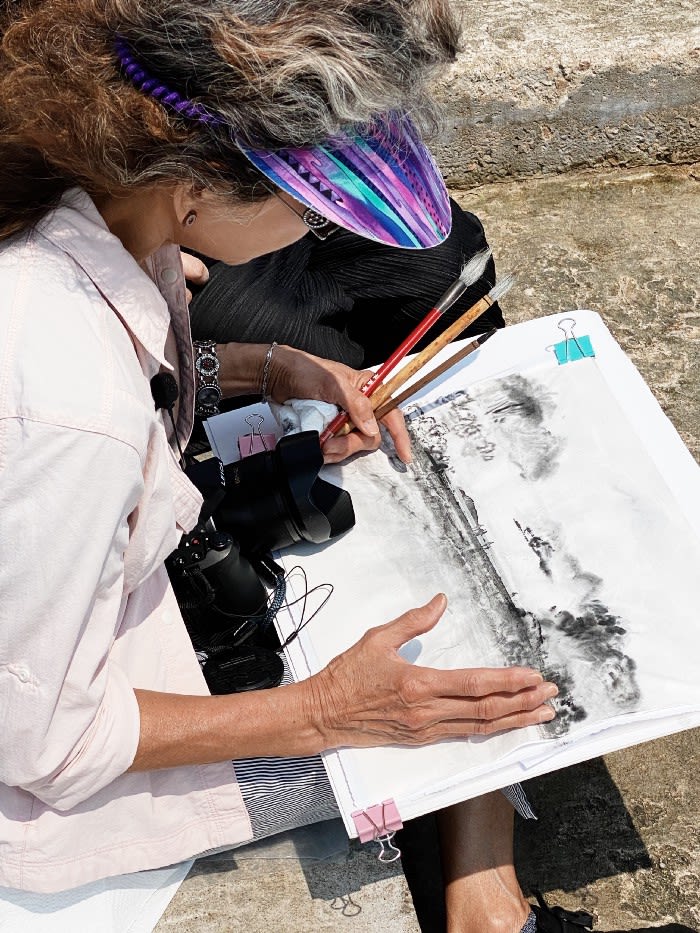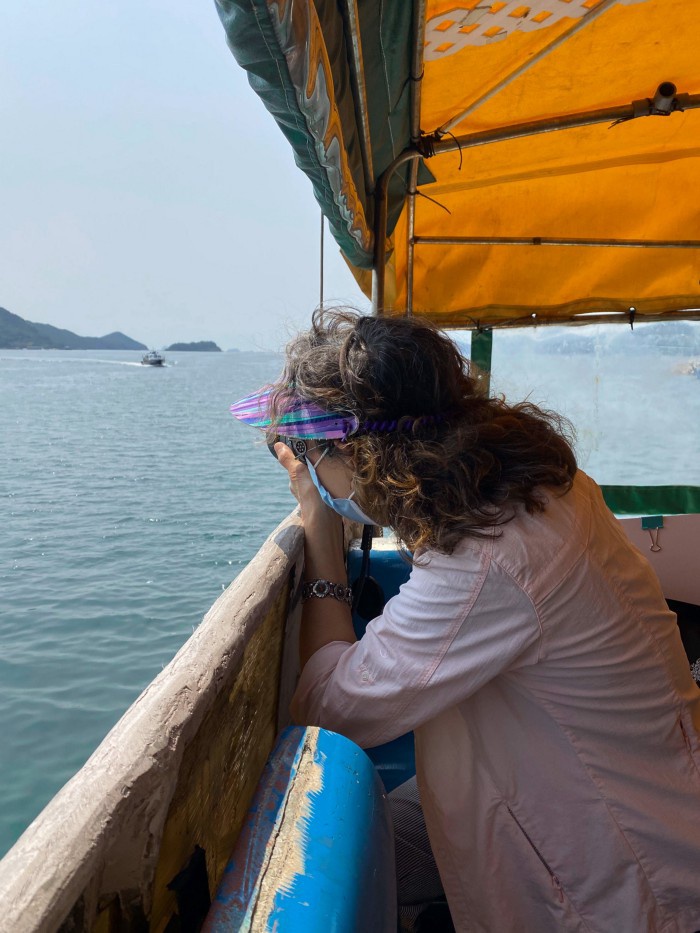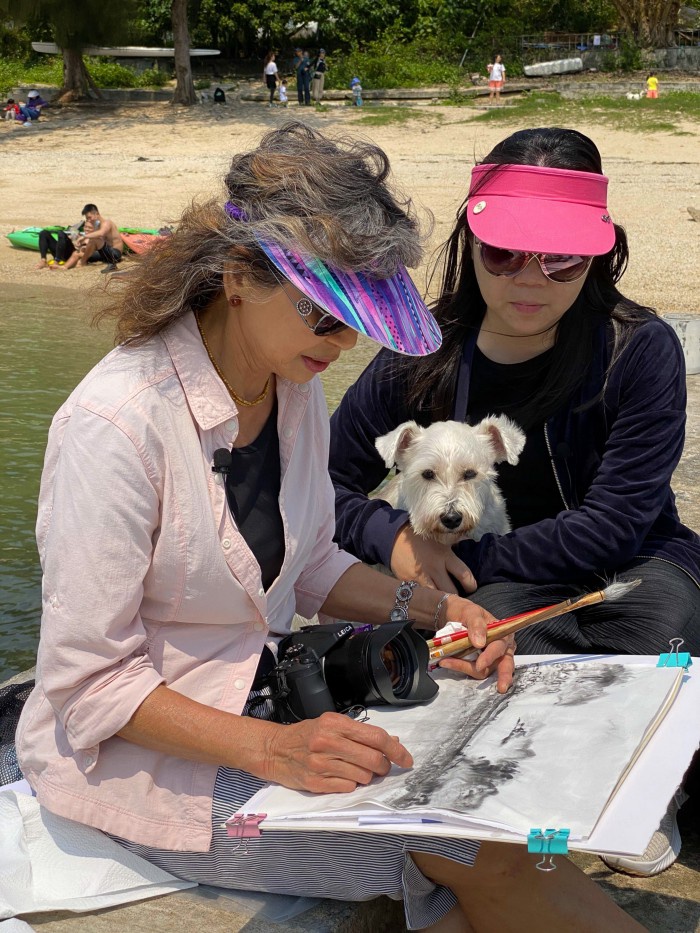
THIS EPISODE, ORA-ORA ACCOMPANIES HONG KONG ARTIST NINA PRYDE FOR AN EXCURSION TO SHARP ISLAND, AS SHE DISCUSSES HER ART-MAKING AS A PAINTER, COLLAGE ARTIST, AND PHOTOGRAPHER.
Dr. Henrietta Tsui-Leung as Henri
Nina Pryde as Nina
Henri: I notice that you love taking pictures with your camera.
Nina: Yes. We are lucky it is a good day today. We will have good lighting for taking pictures. The both of us have been to Sharp Island a few times before. The scenery seems to evolve and change every time we come here. We arrived here this morning, there was a rising tide near the dam.
Henri: Yes, it is.
Nina: Now, everyone can walk on the dam because of the low tide. The landscape is so special here and the rocks have so much texture.

Henri: I’m curious as to why you carry your camera everywhere you go. This is an exceptional Leica camera. Why do you like to take pictures everywhere you go and when did you start having this hobby?
Nina: I take my Leica camera everywhere I go, it is like my loyal companion. I have a bad memory, so the camera automatically helps me capture every moment in my life. The camera has a lightweight plastic shell so it’s convenient for me to bring around. I love taking pictures.
Henri: I seem to remember that it had been a struggle for you when you first started using the first camera you have ever owned. How did you acquire it?
Nina: I got my first camera when I was very young, around 12 to 13 years old. A relative of mine bought a camera and allowed me to play with it. I am lucky to have so many travel opportunities. The camera helps me capture and record all my memories when I go travelling and exploring. Another important thing is to create historic memories. I will then incorporate all these memories into my drawings through the use of collage. Each collage carries historical significance. It allows people to understand the historical context of a monument or architecture. All of these can change or disappear in 10, 20 or 100 years.
Henri: Before you create your art, you will think about what you’d like to put in your drawing first. You will take photographs and then later incorporate them into your paintings. How did you first have the idea to transform the pictures you took into xuan paper collages?
Nina: In history, the Song and Tong Dynasties celebrated the concept of photorealism. I would like to reintroduce this traditional concept into modern times. This is why I like to put my photographs into my paintings to convey a sense of realism and incorporate a modern meaning into my work. Artists are always infatuated with beautiful scenery and landscapes.
Henri: The paper you are using is not any normal paper. Is this xuan paper?
Nina: This xuan paper is a souvenir gifted to me by a student who went to Japan. It is easy to buy hard paper here, but it’s very difficult to acquire xuan paper.
Henri: I see that you have brought with you a lightweight drawing board and many good quality xuan papers.
Nina: I have to stack and clip everything up because it tends to get very windy here. The clips hold onto the papers when I draw. For the dam there, I would portray it this way.
Henri: There are many ways to draw landscape. Some people sketch, some use watercolour. Nina likes to bring with her trusty paintbrushes that glide smoothly on paper. She also brings with her ink, water and markers.
Nina: I brought with me Western paintbrushes as well. I use different paintbrushes for different scenarios. I am using ink now to paint the water and mountains. When we first got here, the tide was still high. Now we can see the whole dam. The view is very enticing.

Henri: When you draw landscapes, do you contemplate a lot or are you in a very relaxed state of mind?
Nina: When I draw landscapes, I have to be very focused and attentive. I have to use my heart to paint. I do not just nonchalantly or casually pick a landscape and draw carelessly. I will observe the proportions of a certain landscape and think about the ways I can translate it into my drawing. I will then manage the way the landscape is presented in my work. I will use a photocopier to photocopy my photographs onto xuan paper. The pictures are a visual reminder of my travelling memories and I will then incorporate these treasured memories into my work. When I see peculiar and special architecture in a foreign country or when I observe a particular culture I deeply admire, something like traditional clothing or art, I would like to preserve them and put them in my own work as collages. The collage in itself is a piece of art. I put a lot of time and energy into making these collages.
Henri: Why is that?
Nina: I have to consider what the whole painting would look like. For example, if the people here on this collage are larger than the hills itself, then it would not make sense. I do not casually take photographs without considering the outcome of my painting, I put a lot of thought in it. I have to decide whether to use short lens, medium lens or long lens. After having taken the photographs, I will go to a photo shop to print out the photos. After that, I would copy the photos onto xuan paper.
A lot of times, I can only pick one collage out of ten collages to be used in my work as I am constrained by the whole landscape and direction of the painting. For example, if I use this angle, I cannot place my dam collage here. I would have to place it towards the left. I would therefore take a lot of photographs using different angles and perspectives. Firstly, I will adjust the placement of my collage. This is the dam and that is the hill. People will walk from the dam towards the hill. I will leave out a space for it in my painting. Now I’m using glue.
Henri: You have a lot of different tricks when drawing landscapes!
Nina: As you can all see, this is the dam. Of course, I would have to extend the hillside to reach the dam. Later on, I will meticulously draw and trace more water and rocks using gongbi. I will draw and attach more rocks to the dam to make my painting feel complete.
Henri: Your paintings are normally in black and white. Do you think colour is important in an ink painting?
Nina: In my opinion, I do see colour in my ink paintings. Haha, and why is that? This is because there is a lot of texture and depth — light and dark — within the hills and water. My painting is not completed yet. But I already see a lot of colours within the black and white landscape. Artists are especially sensitive to colour. Even though all you see is black and white, I actually see a lot of colour that reflects my vibrant mind and thoughts.
Henri: I would like to talk to you about observation. Sometimes when I go on trips with you, you would suddenly disappear out of the blue to go and observe some rocks and I would not be able to find you.
Nina: You cannot be an artist if you don’t have acute focus. You have to have perseverance, patience, and most importantly, passion. I always remember what my mother told me when I was younger. She said, “Other people can do this in one go. I don’t believe you won’t be able to do it as well if you tried ten more times.” Her words are still lodged in my mind to this day. I’ve always been a determined person since I was a child. I don’t give up easily, once I have set goals, I would not stop until I reached them. I have been teaching yoga for twenty years. People who do yoga would know that there are some very challenging yoga poses. You have to have a strong will in order to complete those movements. This mentality applies to all aspects of my life. I keep reminding myself to have perseverance to overcome all obstacles and challenges.
Henri: What do you see in your future? Do you have any more aspirations?
Nina: Every day I wake up I would think of going back to my studio to finishing my painting. Once I am finished with one painting, I would become very impulsive and would immediately want to start another painting. I would not be able to sleep for the next few days as I would be thinking what I would like to incorporate into my new creation. I would begin thinking what collages I would like to put in — locations in Hong Kong or in foreign countries, children or architecture? These thoughts would keep swirling in my heart and mind and I would not be able to sleep. Because I am so impulsive, I would immediately start working on this painting. I could only sleep once I have started working. Then I would become very bothered again as I wanted to complete this painting as soon as possible. Once I’ve completed that painting, I would itch to start another one. This cycle goes on and on and never stops.
I think I am a very impulsive and ambitious person. I would want every one in the world to know my name, to know that Nina Pryde creates historically significant artwork using collages of monuments and architecture, and to know that I have never stopped creating work that presents my artistic values and ideals. I would like my work to be appreciate by people, I feel very happy and fulfilled to know that people appreciate my work.
Life is very vibrant, it is filled with all sorts of colours — red, orange, yellow, green, blue, purple. Artists are open-minded and have vision. There are beautiful colours within our heart and soul. To create great work we need to translate what we have in our hearts onto the paper. Imagination and ambition are keys to an artist’s sense of fulfilment.
ABOUT ORA-ORA LIVE
Each week, Ora-Ora will speak with various members of the art community — including artists, curators, academics and other professionals working in the cultural sector — to address topics of interest related but not limited to Hong Kong’s art and cultural scene. The series aims to be an outlet for creativity and a means to connect with peers who share similar interests. The episodes will also available live on Ora-Ora’s Instagram (@galerieoraora), Facebook (Galerie Ora-Ora) and later on Ora-Ora’s YouTube channel.
